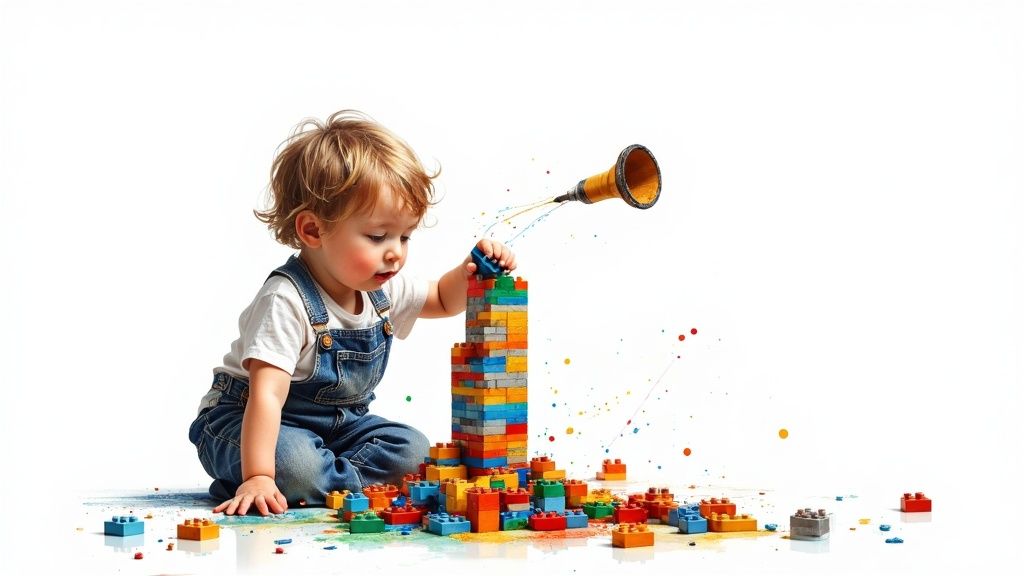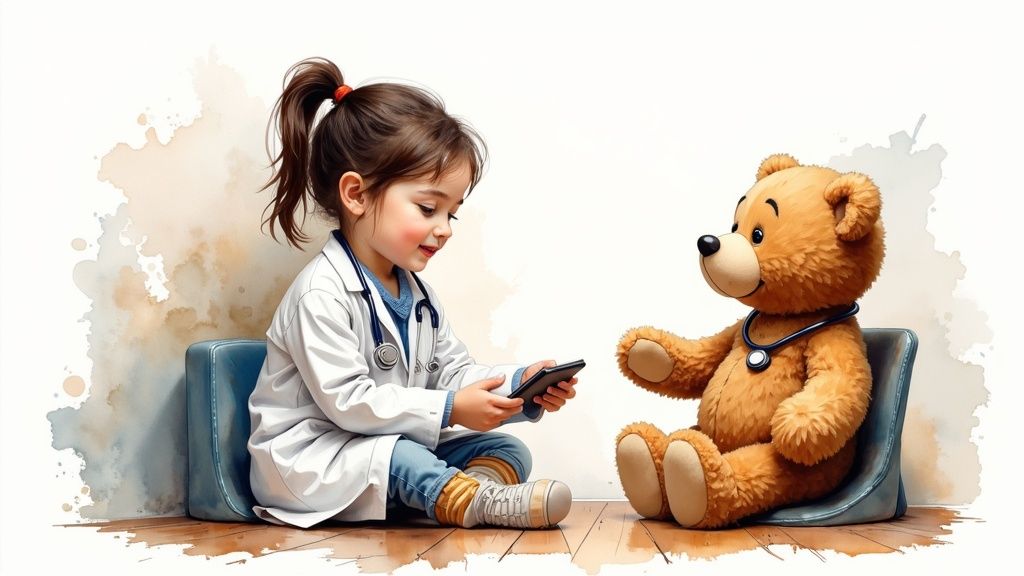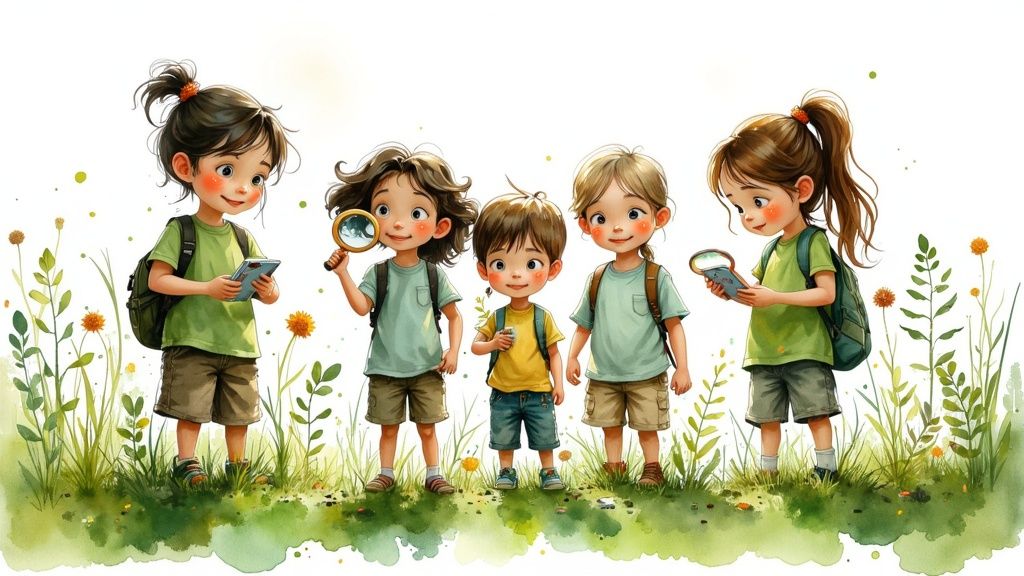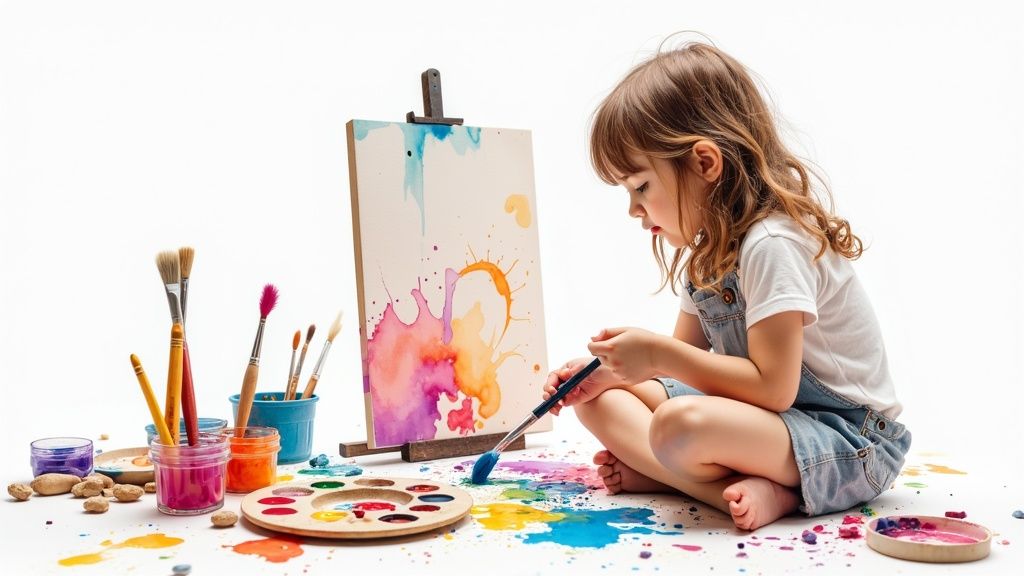10 Learning Through Play Examples: The Power of Playful Learning
February 19, 2025

Dive into the World of Playful Learning
Think back to your early childhood - finger painting masterpieces, building towers with blocks, and creating imaginary worlds. These activities were far more than just playtime. From the first kindergartens designed by Friedrich Froebel to Maria Montessori's hands-on learning methods, educators have long recognized that play is essential for child development.
When children engage in play, they naturally explore, experiment, and discover. By setting up the right environment with a mix of structure and freedom, we can help kids develop critical skills like:
- Problem-solving abilities
- Creative thinking
- Social interaction
- Critical reasoning
The real magic happens when learning feels like play rather than work. The key is finding that sweet spot between challenging activities and pure fun. Children learn best when they're fully engaged and don't even realize they're building important life skills.
Get ready to discover 10 practical ways to transform everyday activities into exciting learning adventures. Whether you're a parent looking to make learning more engaging, a teacher seeking fresh ideas, or anyone interested in child development, you'll find actionable strategies to make education more playful and effective.
1. Block Building and Construction Play

Nearly everyone has childhood memories of building with blocks - whether crafting castles, towers, or spaceships. But block play goes far beyond simple entertainment. It's a powerful learning tool that helps develop essential skills like spatial reasoning, math concepts, problem-solving abilities, and early engineering understanding through hands-on exploration.
When children play with blocks, they engage in open-ended discovery of how shapes work together in three dimensions. As they stack, balance, and manipulate blocks of different sizes, they build fine motor skills naturally. Simple activities like counting blocks or comparing sizes introduce early math concepts. Creating a tower twice as tall as another teaches ratios and proportions through play.
The developmental benefits are clear. Block play enhances spatial awareness - a skill needed for reading maps, following directions, and even everyday tasks like packing efficiently. It builds problem-solving capabilities as children figure out how to construct stable structures. Creative thinking flourishes as basic blocks transform into complex worlds through imagination. This type of play also teaches valuable lessons in patience and persistence.
A few practical considerations exist. Quality block sets can be expensive, especially branded construction toys. Storage space is needed, and small pieces require supervision for young children. However, the educational value far outweighs these minor challenges.
Block play has deep educational roots, championed by pioneers like Friedrich Froebel, who created kindergarten, and Maria Montessori. LEGO brought construction play to homes worldwide. Today, blocks remain central to early education - from kindergarten classrooms to STEM programs to creative maker spaces.
Key tips for maximizing learning through block play:
- Begin with simple blocks before moving to complex construction sets
- Encourage storytelling during building activities
- Provide plenty of unstructured exploration time
Research shows real impact: Studies link early block play to stronger math skills later in life. Professional architects often start designs with physical models, showing how childhood building skills transfer to careers. Think of block play as an introduction to architecture and engineering principles.
You might be interested in: Age-Defying Cognitive Development Activities Blueprint for more ways to boost cognitive skills through play.
Block building offers both entertainment and education. It gives children a hands-on way to learn critical thinking, spatial skills, and creative expression - making it a perfect activity for development at any age.
2. Dramatic and Pretend Play

Children's make-believe play is much more than simple entertainment - it's a vital part of their development. When kids engage in role-playing and imaginative scenarios, they build crucial social, emotional and thinking skills. Think of it as their own learning lab where they can try out different roles and situations safely.
During dramatic play, children create imaginary scenarios that help them develop language skills and process their emotions. Whether they're playing restaurant, doctor's office, or superhero adventures, kids are actively making sense of the world around them through creative expression.
Real Examples in Action:
Watch a group of kids running their pretend restaurant - one takes orders, another "cooks" imaginary meals, while someone else handles the play money. This simple scene actually shows complex social skills at work: kids must negotiate roles, work together, and solve problems. Research shows that regular dramatic play helps children become more empathetic and socially capable.
History and Growth:
While imaginative play has always been part of childhood, its educational value gained recognition through the work of educators like Vivian Gussin Paley, who studied storytelling and play in early learning. The Reggio Emilia teaching approach also highlights how important it is to give children rich environments for symbolic play and creative expression.
Tips for Supporting Dramatic Play:
- Offer simple props: Basic items like boxes, blankets, and household objects can spark endless creative scenarios
- Let kids lead: Step back and allow children to direct their own play stories and scenarios
- Change up themes: Keep interest high by suggesting new play themes - from post office to space station
- You might be interested in: Creative Activities for Preschoolers. Find more ideas for boosting creativity in young kids.
Benefits:
- Builds empathy
- Improves communication
- Develops social confidence
- Encourages creativity
Challenges:
- Young children may need gentle guidance
- Basic props and materials required
- Some kids need encouragement to join in
Dramatic play helps children develop essential life skills through fun and creativity. By giving kids chances to explore through pretend play, we help them become confident, caring, and imaginative individuals.
3. Educational Board Games
Board games offer a clever way to make learning fun and engaging! These games blend education with enjoyment, helping players build skills while they compete and socialize. From improving vocabulary with word games to learning money management through economics-focused games, board games support many different learning goals.
These games work well because they engage players in multiple ways. Rules teach kids about following instructions and understanding systems. Taking turns helps develop patience and social skills. Players build critical thinking abilities as they plan moves and adjust their strategy - all while having fun rather than feeling like they're studying.
Take Scrabble for example. Beyond just making words, players expand their vocabulary, think strategically about letter placement, and practice basic math when adding up points. Monopoly teaches fundamental concepts about money, property, and negotiation (even if it sometimes leads to family debates!). Chess develops planning skills and the ability to think multiple moves ahead.
Companies like Milton Bradley, Hasbro, and ThinkFun helped pioneer educational gaming by showing how learning and entertainment could work together. Today, there are games for every age group, learning style, and subject area.
Key Benefits:
- Rule-based learning: Helps kids understand how to follow instructions and guidelines
- Turn-taking practice: Builds patience and social awareness
- Strategic thinking: Develops planning and problem-solving abilities
- Subject learning: Makes academic concepts more engaging and memorable
Advantages:
- Makes learning more enjoyable and interactive
- Teaches important life skills through structured play
- Builds critical thinking and strategy skills
- Promotes social interaction and communication
Potential Challenges:
- Competition can frustrate some children
- Games often require dedicated time to play
- Complex rules may discourage some players
- Not all kids enjoy the same types of games
Tips for Success:
- Match games to age level: Choose games suited to the child's development stage
- Focus on learning: Emphasize growth and fun over winning
- Try cooperative games: These promote teamwork rather than competition
- Be patient: Allow time for learning rules and developing skills
Educational board games deserve recognition as valuable learning tools because they naturally blend education with entertainment. When chosen thoughtfully and played in a supportive environment, board games help develop cognitive abilities, social skills, and an enthusiasm for learning that can last a lifetime.
4. Outdoor Nature Play

Some of the most meaningful learning happens when kids step outside. Outdoor play isn't just about running around - it's about igniting curiosity and building real understanding through direct experiences with nature. From exploring wooded areas to building hideouts with sticks to examining leaves up close, children connect with their environment in ways that spark imagination and create lasting curiosity.
Getting hands-on with nature engages all the senses. Kids climb trees, collect interesting rocks, splash in puddles, and listen to birds singing. These rich sensory experiences support healthy development while making learning fun and memorable. The smells, textures, sounds and sights of the natural world create an immersive classroom without walls.
The positive effects are clear: outdoor play boosts physical health, motor skills, and coordination. It helps kids develop respect for nature and environmental awareness. Time outside also provides excellent stress relief for both children and adults.
A few practical considerations come into play. Weather can impact outdoor activities, proper supervision is important, and basic safety guidelines around things like insects or uneven ground need to be followed. But with some common sense precautions, the benefits far outweigh any challenges.
This approach has gained momentum thanks to the Forest School movement, which started in Scandinavia. Author Richard Louv's work "Last Child in the Woods" brought more attention to how vital nature connection is for kids' wellbeing.
We're seeing this play out in real settings. Forest schools and nature-based preschools continue growing in popularity. More playgrounds now incorporate natural elements like logs, sand, and water features. Even simple backyard gardens give kids opportunities to engage with nature.
Here are a few tips to get you started:
- Create outdoor exploration kits: Fill a backpack with magnifying glasses, bug viewers, small shovels, and field guides to enhance the experience.
- Include seasonal activities: Embrace the changing seasons. Collect leaves in autumn, build snow forts in winter, plant seeds in spring, and search for insects in summer.
- Incorporate scientific observation: Encourage children to ask questions, make predictions, and document their findings.
Outdoor nature play earns its place on this list by offering complete learning experiences. It helps form lasting bonds between children and their environment while supporting physical, cognitive and emotional growth. The simple act of stepping outside opens up endless possibilities for discovery through play.
5. Music and Movement Play
Moving and making music together sparks joy while building essential skills. When our bodies connect with rhythm and melody, we naturally tap into powerful learning pathways that boost coordination, listening abilities, and creative expression.
Have you ever caught yourself swaying to a catchy tune without thinking about it? That natural response shows how deeply music connects to our physical movement. This natural inclination makes music and movement play an incredible tool for growth.
Core Elements
Music and movement activities focus on key skills:
- Rhythm mastery: Starting with simple beat-keeping and progressing to complex patterns helps develop musical timing
- Physical development: Dancing and moving improves balance, coordination and spatial awareness
- Pattern skills: Recognizing musical phrases and repeated movements builds cognitive abilities
- Creative freedom: Exploring movement and different musical styles nurtures imagination and self-expression
Key Benefits
When children engage in music and movement play, they gain:
- Better memory: Learning songs and dance sequences strengthens recall
- Improved coordination: Moving to music develops motor control
- Sharper listening: Following musical cues enhances auditory processing
- Greater confidence: Performing and expressing through music builds self-assurance
Practical Considerations
A few things to keep in mind:
- Space needs: Movement activities need a clear, safe area
- Sound levels: Musical play can get noisy! Plan accordingly
- Equipment: While many activities need minimal supplies, specialized instruments require investment
Getting Started
Programs like Kindermusik and Dalcroze classes offer guided music and movement education. Dance classes from ballet to hip-hop provide structured options. Even basic games like musical chairs or pat-a-cake engage these skills effectively.
Tips for Home and Classroom
Try these simple ideas:
- Use basic percussion instruments like shakers and tambourines
- Share music from different cultures and traditions
- Act out stories with music and movement
- Create musical games and activities
Historical Context
Teaching methods like Orff Schulwerk and Dalcroze Eurhythmics established key principles of combining music, movement, drama and speech. These approaches showed how naturally music and movement work together to support learning.
Why It Works
Music and movement play creates multi-sensory learning experiences that build skills across different developmental areas. Beyond just teaching specific abilities, it fosters musical appreciation, sparks creativity, and boosts self-confidence - all while keeping kids engaged and having fun.
6. Digital Learning Games
Learning through digital games has become an effective part of modern education. These interactive educational tools blend engaging gameplay with targeted learning objectives. When children think they're just playing, they're actually mastering new concepts and skills.
The best educational games include key features that boost learning effectiveness. Kids get instant feedback on their actions, helping them grasp concepts quickly. The difficulty adjusts based on performance, providing the right level of challenge. Progress tracking lets parents monitor development, while colorful graphics and sound effects maintain interest.
Research shows clear advantages of game-based learning. Kids stay motivated through immediate feedback and self-paced progress. The high engagement leads to better retention, while built-in analytics reveal areas for improvement. Popular examples include Minecraft: Education Edition for history and science, ABCmouse for early learning fundamentals, and Duolingo for language skills.
Like any tool, digital games have limitations to consider. Screen time needs careful management and balance with offline activities. Access to devices and potential technical issues can create barriers. While games excel at engagement, they may not fully replace hands-on learning experiences.
Tips for Making the Most of Educational Games:
- Set clear time boundaries: Balance digital play with physical activities, reading, and creative projects
- Focus on quality content: Choose games from established educational providers that align with learning goals
- Connect virtual and real: Link in-game concepts to everyday experiences and hands-on learning
Leading platforms like Khan Academy, PBS Kids, and Microsoft Education offer extensive libraries of educational games. Their mix of free and paid resources makes quality learning accessible to diverse students. You might be interested in: Digital Transformation in Education to learn more about technology's role in learning.
Digital games earn their place among top educational tools by combining engagement with effective instruction. Understanding both benefits and limitations helps parents integrate these resources thoughtfully. The key is finding the right mix of digital and traditional learning experiences. Read also: [How Technology Enhances Learning Through Play]. This balanced approach maximizes the strengths of both interactive games and classic teaching methods.
7. Sensory Play
Let kids get their hands dirty and watch them learn! Sensory play means exploring through touching, smelling, seeing, tasting, and hearing. Children naturally love squishing playdough, digging in sand, or splashing in water - and what seems like simple play actually builds important skills.
Behind all that fun, kids are developing crucial abilities. When a child pours water between cups, they're learning about volume. Sorting colorful objects teaches early math concepts. Even basic activities like squeezing and molding strengthen the hand muscles needed for writing later on.
Key Benefits of Sensory Play:
- Engages multiple senses at once through hands-on exploration
- Builds fine motor skills through manipulating different materials
- Encourages natural curiosity and scientific thinking
- Develops brain connections through new sensory experiences
Advantages:
- Strengthens neural pathways essential for learning
- Improves coordination and dexterity
- Expands vocabulary as kids describe what they're experiencing
- Provides calming activities that can help reduce stress
Challenges to Consider:
- Expect some mess - Use drop cloths and designated play areas
- Requires setup time - Plan activities in advance
- Basic supplies needed - Start simple with household items
Real Examples in Action:
Watch a child playing in a sand table - they're solving problems as they figure out how to build structures, strengthening muscles as they dig and pour, and using their imagination to create worlds of their own. Similar learning happens with playdough, sensory bins filled with rice or beans, and water play.
Origins and Growth:
Early childhood experts like Maria Montessori recognized the importance of hands-on sensory learning. Her methods, along with Jean Piaget's research on cognitive development, helped establish sensory play as a core element of early education.
Tips for Getting Started:
- Use natural items like pinecones, smooth stones, and leaves
- Change materials regularly to maintain interest
- Make cleanup part of playtime to teach responsibility
Popular Sensory Activities:
- Sand and water tables
- Rolling and shaping playdough
- Exploring texture bins (rice, beans, pasta)
- Finger painting
- Playing with slime
Adding sensory play to a child's routine provides rich opportunities for growth and learning. So set up that play space, embrace the creative chaos, and watch your child discover the world through their senses!
8. Art and Creative Play

When kids pick up crayons and start creating, they're doing much more than making pretty pictures. Art and creative play helps children discover themselves, explore materials, and develop critical thinking skills. From finger painting to sculpting with clay, these activities give kids essential tools for expressing their inner world.
The magic happens in the process, not the final product. Watch a child mix colors or squish clay between their fingers - their face lights up with pure joy and discovery. This natural approach to creating removes the pressure of perfection and lets imagination soar freely.
Consider the countless ways kids can explore: sensory art stations for experimenting with textures, clay modeling for building hand strength and spatial awareness, or group murals that teach cooperation. The Reggio Emilia educational method calls art the "hundred languages of children" because it gives them so many ways to share their thoughts and feelings.
You can see the impact everywhere. Picture toddlers giggling as they make handprints with paint, discovering how colors blend. Or watch teenagers work together on a community mural, taking pride in making their mark on their neighborhood. Even adults find peace and joy in creative activities like drawing or pottery.
Here's how to make art play work:
- Let the process be the point: Skip corrections and let exploration lead the way
- Stock up on diverse materials: Go beyond basic supplies to include natural items and recycled materials
- Set up a creative zone: Designate a special spot for art, whether it's a corner table or portable supply cart
Benefits:
- Builds self-expression and communication abilities
- Develops physical coordination and fine motor control
- Strengthens problem-solving and creative thinking
- Grows confidence and self-worth
Challenges:
- Requires cleanup after activities
- Art supplies can get costly
- Needs dedicated space for projects
While art activities mean dealing with some mess and buying materials, the growth and joy they bring make it worthwhile. Creative play gives kids essential tools for learning and self-discovery that last a lifetime.
9. Physical Play and Games
When it comes to effective learning methods, physical play and games pack a powerful punch. They combine movement with mental growth, making learning feel more like recess than work. Kids build key skills while running, jumping, and playing - often without even realizing they're learning.
Want to see physical learning in action? Picture kids solving math problems between obstacles in a backyard course, or counting passes during a basketball game. The options are endless - from classic playground games to structured sports to creative movement challenges that weave in academic concepts.
The best part is how adaptable physical learning can be. You can easily adjust activities based on age, skill level, and what you want to teach. Need to work on cooperation? Set up a team relay race. Looking to boost problem-solving? Create a physical puzzle course kids have to navigate together.
Key Benefits of Physical Learning:
- Active Movement: Helps kids stay healthy while learning
- Social Skills: Builds teamwork and communication naturally
- Following Rules: Teaches fair play and boundaries
- Critical Thinking: Develops strategic planning abilities
Advantages:
- Gets kids moving and active
- Improves social interaction
- Teaches good sportsmanship
- Develops motor skills and coordination
Challenges to Consider:
- Weather can limit outdoor activities
- Requires adequate space
- Need proper supervision for safety
Success Stories:
Organizations like PE4Life show how physical learning works in practice. They focus on quality physical education that empowers healthy choices. The Sport Education model takes this further by giving students different team roles to understand teamwork from all angles. Studies regularly confirm that active learning boosts academic success.
Tips for Getting Started:
- Make activities welcoming: Ensure everyone can participate comfortably
- Adapt for different abilities: Change rules or equipment as needed
- Add learning elements: Mix in academic concepts naturally. For young kids, try alphabet hopscotch. Older students might enjoy solving math problems during active games.
By blending movement with learning, physical play creates engaging experiences that help kids grow in multiple ways. It's an approach that makes learning fun while supporting both physical and mental development.
10. Scientific Exploration Play
Getting hands-on with science is one of the most engaging ways for kids to learn and discover the world around them. From simple kitchen experiments to backyard nature studies, scientific play helps children understand core concepts while having fun. It's not about formal lessons - it's about sparking wonder and curiosity through active exploration.
Key Elements of Scientific Play:
- Learning by doing: Kids get to experiment and discover for themselves, not just read about concepts
- Building observation skills: Learning to notice details, track changes, and record findings
- Making predictions: Developing and testing hypotheses through hands-on trials
- Following natural curiosity: Letting kids explore what interests them most
Real-World Examples:
Making a baking soda and vinegar volcano teaches chemical reactions. Setting up a bird watching station helps kids understand ecosystems. Building bridges from household items introduces engineering principles. These activities make complex ideas tangible and fun.
Making Science Approachable:
Programs like Bill Nye the Science Guy, National Geographic Kids, and interactive science museums have helped show that science can be entertaining and engaging for all ages. Their work demonstrates how learning naturally happens through play.
Benefits and Challenges:
Key Benefits:
- Builds critical thinking and problem-solving abilities
- Encourages questioning and exploration
- Teaches basic scientific methods
- Develops confidence through experimentation
Main Challenges:
- Certain activities need adult supervision for safety
- Setup and materials take preparation time
- Supply costs can add up (though many experiments use household items)
Tips for Getting Started:
- Begin with basics: Use simple experiments with common materials
- Keep records: Have kids document observations in a science journal
- Ask questions: Encourage thinking with "What do you predict?" and "Why did that happen?"
Easy Activities to Try:
Set up a simple weather station to track temperature and rainfall. Plant bean seeds in clear containers to watch roots grow. Make homemade slime to learn about chemical properties. The key is making it interactive and enjoyable - when kids are having fun, the learning happens naturally. With each activity, you're helping develop a lifelong love of discovery.
Learning Through Play: 10-Method Comparison Matrix
| Methodology | 🔄 Complexity | ⚡ Resources | 📊 Outcomes | 💡 Ideal Use Cases | ⭐ Key Advantages |
|---|---|---|---|---|---|
| Block Building and Construction Play | Moderate – open-ended build with planning | Moderate to High – cost & storage requirements | Enhances spatial reasoning, math integration, problem-solving | STEM centers, maker spaces, classrooms | Fosters creativity and persistence |
| Dramatic and Pretend Play | Basic to Moderate – sometimes needs adult guidance | Low to Moderate – requires varied props & costumes | Develops social skills, language, and emotional insight | Role play in homes and classrooms | Enhances empathy and communication |
| Educational Board Games | Moderate – rule-based structure | Moderate – investment in games and time | Promotes strategic thinking, rule following, social interaction | Family game nights, classroom activities | Merges fun with educational learning |
| Outdoor Nature Play | Moderate – simple yet weather-dependent planning | Low – relies on natural surroundings | Improves physical health, environmental awareness, sensory engagement | Outdoor exploration, nature-based programs | Encourages sensory discovery and environmental care |
| Music and Movement Play | Moderate – requires organization and space | Moderate – instruments and room space needed | Boosts coordination, listening skills, and creative expression | Preschool settings, movement classes | Enhances motor skills and self-expression |
| Digital Learning Games | High – technology-dependent and adaptive | High – needs devices and reliable digital access | Offers immediate feedback, self-paced learning, and engagement | Tech-enabled classrooms, remote learning | Highly engaging with adaptive content |
| Sensory Play | Low to Moderate – messiness requires prep | Low to Moderate – basic materials and cleanup | Develops fine motor skills, cognitive processing, and sensory integration | Early childhood centers, therapy sessions | Stimulates neural connections and tactile exploration |
| Art and Creative Play | Moderate – process-oriented and exploratory | Moderate – art supplies and dedicated space | Encourages creative thinking, self-expression, and visual reasoning | Art classes, creative workshops | Boosts confidence and fosters artistic exploration |
| Physical Play and Games | Low to Moderate – simple rules but structured play | Low to Moderate – availability of space and minimal equipment | Promotes teamwork, coordination, and physical development | Recess, PE classes, sports programs | Supports physical health and collaborative skills |
| Scientific Exploration Play | Moderate to High – requires experimental setup | Moderate – safety materials and science supplies | Enhances critical thinking, curiosity, and application of the scientific method | STEM workshops, science labs | Sparks inquiry and problem-solving abilities |
Embrace the Power of Play
Playing and learning work beautifully together. Whether kids are stacking blocks into tall towers, getting their hands dirty exploring nature, or moving their bodies on the playground - they're developing critical skills while having fun. Games challenge strategic thinking, art projects spark creativity, and active play builds physical abilities. The key is finding ways to blend enjoyable play activities with learning goals.
Successful play-based learning adapts to fit each child. Little ones thrive with hands-on sensory activities and simple building projects. Older children engage well with more complex games, educational apps, and creative outlets. That's what makes play such an amazing learning tool - it can be shaped to work for any subject, age, or setting.
Technology is opening up exciting new ways to learn through play. Educational apps and games can now provide personalized learning experiences that adapt to each child's needs and interests. These digital tools make it easier than ever to create engaging activities that help kids master new concepts.
Key Takeaways:
- Play makes learning naturally engaging and fun
- Play develops important skills across multiple areas
- Play activities can be customized for different ages and learning styles
- New technology enhances play-based learning opportunities
Looking for a fun way to reinforce learning concepts? ColorPageAI helps you create custom educational coloring pages. Whether you're a parent, teacher, or therapist, you can design coloring sheets that bring any subject to life. Imagine coloring pages featuring exploding volcanoes with history facts or cell division with labeled parts - the creative possibilities are endless! Try ColorPageAI today and get your first five coloring pages free with no credit card needed. Visit ColorPageAI to start creating.
Ready to start coloring?
Join ColorPage.ai today and get 5 free credits to create your own custom coloring pages!
Start creating